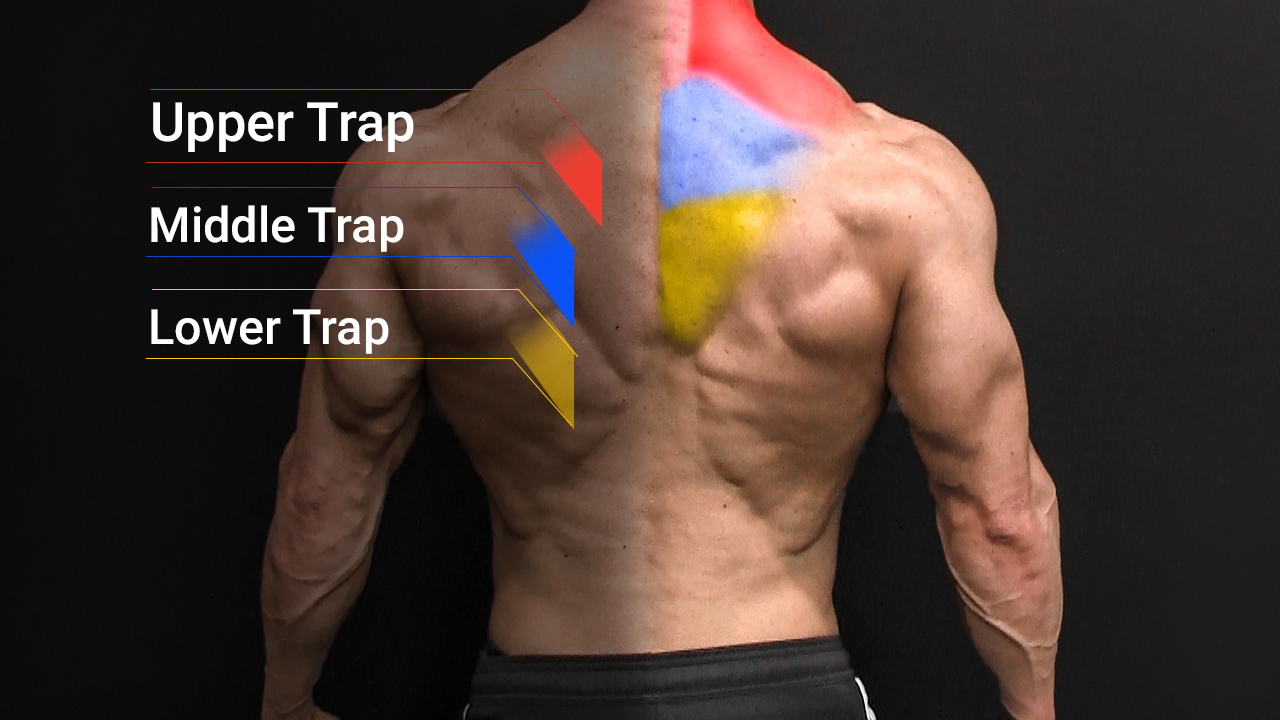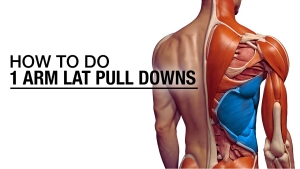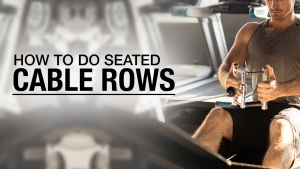
THE ULTIMATE TRAP WORKOUT GUIDE
Too many of you – you know who you are – sideline some of the most important posterior muscles.
I’m talking, of course, about your traps.
You either fail to work them out regularly or you don’t use the best techniques and exercises.
Even if traps aren’t necessarily your preferred muscles to work on, it’s essential that you don’t push them to the back burner!
In this ultimate guide to trap-focused workouts, I’ll supply you with a total understanding of the trap muscles and explain their significance.
I’ll also give you the best trap exercises and training recommendations to maximize your gains.
Don’t have access to a full gym? Not a problem!
This guide to the traps is for everyone, regardless of experience level and how much fitness equipment you have.
Here’s a sneak peek at the topics that this guide to trap strength training will cover:
1) TRAP MUSCLES ANATOMY
It all starts with getting to know your trap muscles.
The more familiar you are with the trap muscles, the easier it’ll be to activate them for a full and more intense muscle contraction.
A great mind-to-muscle connection is key to achieving optimal results.
Here’s a complete rundown of the upper back muscles – from top to bottom – including where to find the traps and what functions they serve.
UPPER TRAPS

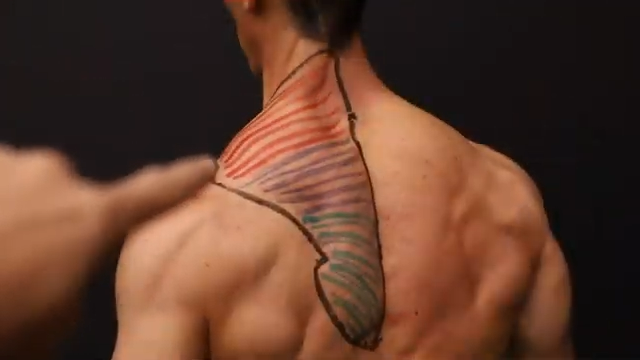
Here’s what upper trap exercises can help you do:
- Shoulder Shrug: The upper traps allow the shoulder blades, or scapulae, to rise. This is what happens when you shrug your shoulders.
- Raising Your Arms: The upper traps, along with other muscles like the serratus anterior, aid in rotating the scapulae upwards, which happens when you lift your arms above your head.
- Neck Movements: The upper traps help with moving your neck back and tilting your head from side to side.
- Keeping Good Posture: The upper traps are super important in helping you maintain correct posture. They assist in keeping the shoulders pulled back and the neck straight. Naturally, this is going to help those of you who spend a good chunk of your day either sitting at a desk or standing for work.
MID TRAPS

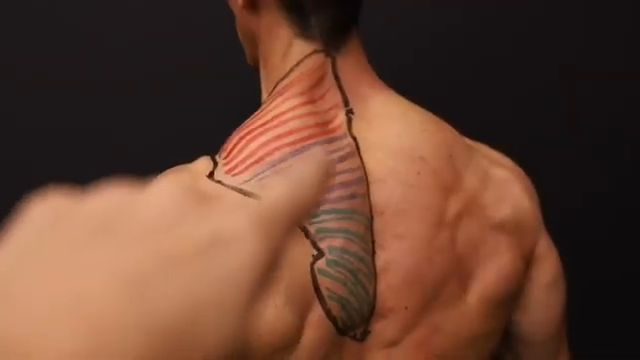
As the name suggests, the mid traps sit right in the middle of your back, sandwiched between the upper and lower traps.
Here are the main functions of the middle trap muscles:
- Retracting Shoulder Blades: Exercises for the mid traps play a crucial role in retracting or pulling the shoulder blades together towards the spine. This action is involved in various movements such as rowing exercises and maintaining balanced posture.
- Assisting in Shoulder Extension: The mid traps help with shoulder extension, which involves moving the arms backward from a forward position. This action is essential for activities like pulling, reaching, and throwing.
- Stabilizing the Shoulder Girdle: Along with the upper traps and lower traps, the mid traps help stabilize the shoulder joint. They work together to support and maintain proper alignment and function of the shoulder complex during various movements.
- Assisting in Rotating the Shoulder Blades: The mid traps assist in rotating the shoulder blades upward, a movement known as upward rotation. This action is important when you raise your arms above your head, such as during overhead reaching or lifting movements.
LOWER TRAPS

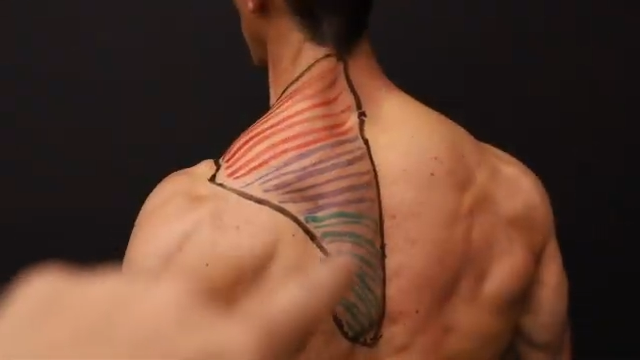
The lower traps can be found in the bottom part of the trapezius muscles, stretching down your spine from the lower shoulder blade area to about the mid-back region.
Here’s what the lower traps do:
- Pulling Down Shoulder Blades: The lower traps help in dragging the shoulder blades down. This is a key move in activities where you reach overhead, like when you’re grabbing something from a high shelf.
- Bringing Together Shoulder Blades: Alongside the mid traps, the lower traps work to pull the shoulder blades together towards the center of your body. You can notice this happening during exercises that mimic rowing movements.
- Lifting Arms Above Head: The lower traps, working in sync with the upper traps and the serratus anterior, assist in rotating the shoulder blades upward like when you lift your arms overhead.
- Maintaining Good Posture: Finally, just like all parts of the trapezius muscle, the lower traps help you maintain proper posture by keeping your shoulder blades in the right position.
2) WHY ARE TRAP WORKOUTS IMPORTANT?
To say the traps are a key muscle is a serious understatement.
Not only do they ensure a healthy and correct upright posture, but well-developed traps also promote functional movement patterns.
These are things you do every day that you don’t think about like raising your arms above your head.
If your traps are weak, it can mess with both your sports performance and your normal day-to-day actions.
And let’s not forgot that when you focus on building your traps, you’re working toward a proportionally balanced physique.
Let’s take this a step further. Here’s why you should take your trap workouts seriously:
ENHANCE POSTURE AND ALIGNMENT
Traps support the neck and shoulders, helping to maintain proper alignment and posture.
With most of us spending large parts of our day sitting at desks, the best trap exercises can combat the effects of a sedentary lifestyle and improve posture.
FUNCTIONAL FITNESS
Since the traps are involved in so many daily movements like shrugging, turning your head, and lifting objects, strengthening these muscles can enhance your functional fitness, making everyday tasks easier.
BOOST OVERALL STRENGTH
Traps are key players in a wide range of physical tasks, from lifting heavy shopping bags to performing a heavy barbell deadlift.
Strengthening them can significantly increase your overall upper body strength, which will directly improve other movements, especially in the weight room.
PREVENT INJURIES
Strong traps can help prevent neck, shoulder, and upper back injuries, especially if you’re straining yourself with constant texting or being hunched over a desk at work.
These muscles are involved in a variety of movements and can provide a buffer and additional support for dynamic movements or heavy lifting.
AESTHETIC APPEAL
From a visual standpoint, well-developed traps can balance out the look of your physique, adding to the coveted “V” shape in men and the hourglass figure in women.
Overall, they contribute to a well-rounded, muscular appearance.
3) WHAT IS THE BEST TRAP WORKOUT?
You know why they’re important to train, and now you need to know which exercises make up the best trap-based workout routines.
Here are my go-to trapezius muscle exercises that support all the benefits I mentioned above.
One thing you’ll notice: None of these exercises take place on an adjustable bench, incline bench or otherwise. There’s a reason for that. I train like an athlete, and I want you to do the same.
That means you’ll be doing most of these exercises from a standing position.
Another thing that might be different in this workout is that you might be surprised not to see certain compound exercises like the Standard Deadlift, Barbell Row, or EZ-Bar Upright Row.
Why?
Because you want an effective exercise for the traps and those exercises aren’t ideal for hitting the traps specifically.
Rep ranges for these exercises will be between 6 to 8 and 15 to 20, depending on how heavy of a weight you’re using.
In general, heavier weights mean you’ll do fewer reps, but more sets. If you are using a light weight, you should perform more repetitions.
Regardless, your focus should always be on high quality reps. Don’t worry about a specific number. Instead, make sure that you are moving through a full range of motion and contraction.
I’m going to list these effective traps exercises based on which part of the trapezius muscle they target. I’ll start this exercise selection with the upper traps and work my way down to the lower trap exercises.
TRAP BAR CARRY

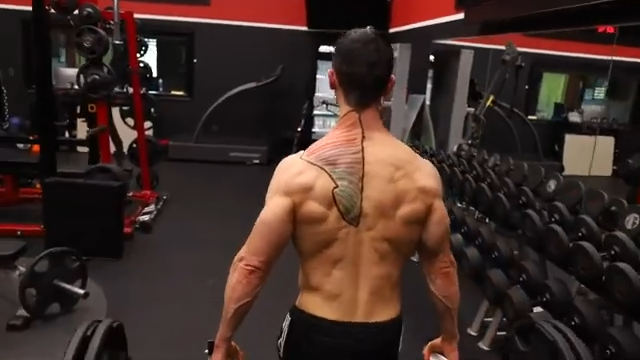
HOW TO DO THE TRAP BAR CARRY:
- We kick off the list with an excellent exercise you may have never done before. Position yourself at the center of a trap bar with feet hip-width apart.
- Bend down, grab the handles, hinge at the hips, and stand up, lifting the trap bar.
- Walk straight taking small steps, focusing on an upright posture, and keeping your core tight. This version of the Farmer’s Carry adds an extra challenge to your stability and balance, so make sure to engage your core and maintain proper form.
WHAT MAKES IT EFFECTIVE: The Trap Bar Carry is a unique variation to the traditional Farmer’s Carry – both are heavy lifts – because of the outward angle of the arms. These heavy carries with the natural orientation of the muscle fibers, targeting the upper traps and providing a more intense contraction.
TRAP BAR SHRUG

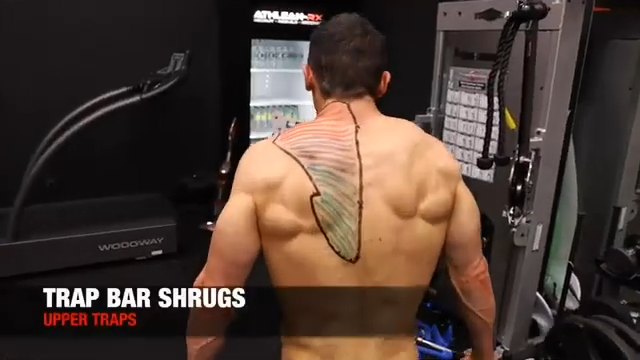
HOW TO DO THE TRAP BAR SHRUG:
- As far as strength exercises go, you can’t beat the Trap Bar Shrug. Stand in the center of the trap bar (hex bar) with feet hip-width apart.
- Grasp the handles and stand tall with arms extended.
- Shrug your shoulders up towards your ears, hold briefly, then lower them down. Focus on mastering the technique before increasing weight.
WHAT MAKES IT EFFECTIVE: The Trap Bar Shrug is ideal for targeting and stretching the upper traps due to how the arms are angled. It also challenges your core strength. For those aiming to build large traps with heavy loads, I can’t recommend this exercise enough.
BACK WIDOW

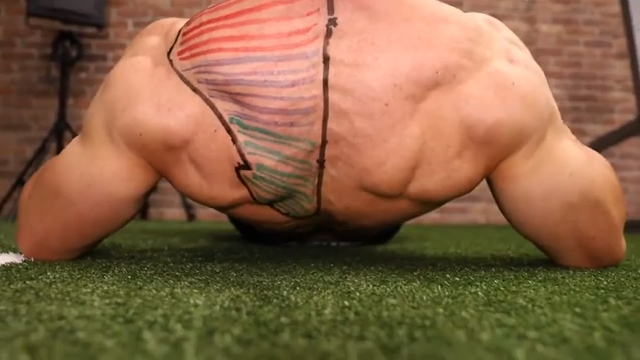
HOW TO DO THE BACK WIDOW:
- It’s tough to say there are official isolation movements for the mid traps, but this is as close as you’ll get. Lie on your back and drive your elbows into the ground.
- Do not extend your arms out. This prevents the focus from shifting to the rear deltoids or triceps.
- Squeeze the mid traps, maintaining constant tension, and release slowly.
- Since you aren’t using any external weight, you want to aim for a higher rep range.
WHAT MAKES IT EFFECTIVE: To isolate the mid traps, focus on driving your elbows back and down instead of using your arms or hands. This essential exercise removes the involvement of the rear delt and directs the muscle contraction specifically to the mid traps.
FACE PULL WITH ELEVATED RAISE

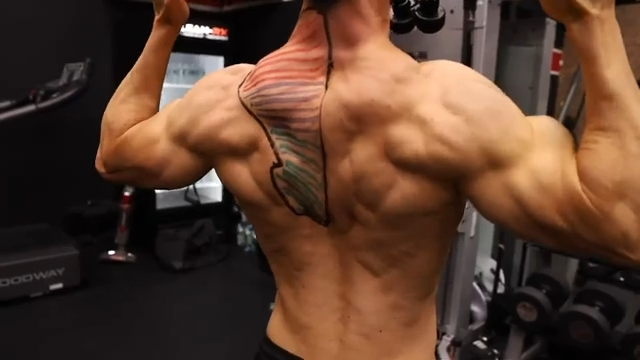
HOW TO DO THE FACE PULL WITH ELEVATED RAISE:
- Using the cable pulley machine, hook up the rope attachment.
- Pull it towards your face while leading with your hands, not the elbows, to prevent shoulder internal rotation. This promotes external rotation and engages the rotator cuff and mid-scapular muscles.
- Bring the cable machine rope attachment next to your ears, then push the rope above your head, hold briefly, and reverse the movement slowly.
- No heavier loads needed here – I’d recommend a light to moderate weight load.
WHAT MAKES IT EFFECTIVE: An exercise for traps muscle like this has the added challenge of pulling you forward, forcing the middle traps to work harder to maintain retraction of the shoulder blades.
CABLE OVERHEAD TRAP RAISE

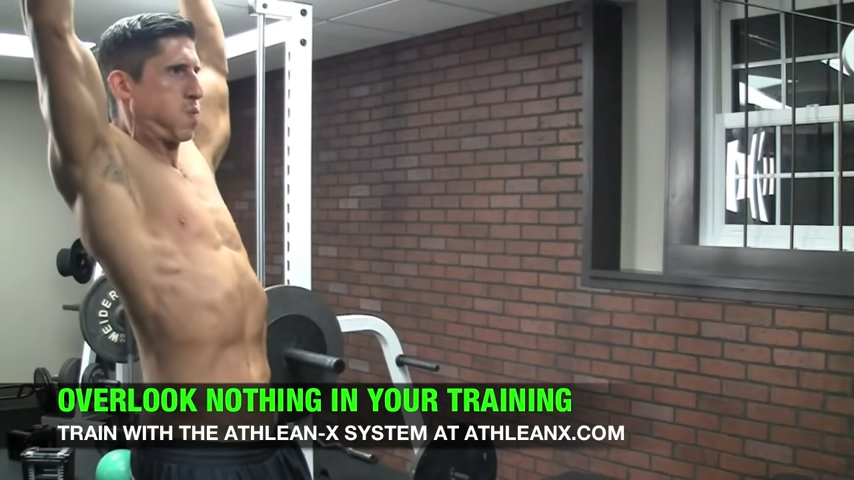
HOW TO DO THE CABLE OVERHEAD TRAP RAISE:
- This one is also known as the Cable Y Raise. Set the cable machine to its lowest setting and grab pulley handle attachments.
- Start with a light weight. Kneel in front of the machine and cross your arms, grabbing the right cable with the left hand and the left cable with the right hand.
- Lift straight up and overhead, feeling the engagement of your lower traps. You might feel this in your core muscles since they are working to stabilize you.
- Pause, squeeze the muscles, and lower slowly. Alternatively, if you have access to resistance bands, you can use them for this exercise.
WHAT MAKES IT EFFECTIVE: By kneeling and using the cable machine handle attachment, you can get rid of unwanted lower body momentum.
STANDING PRONE PRESS

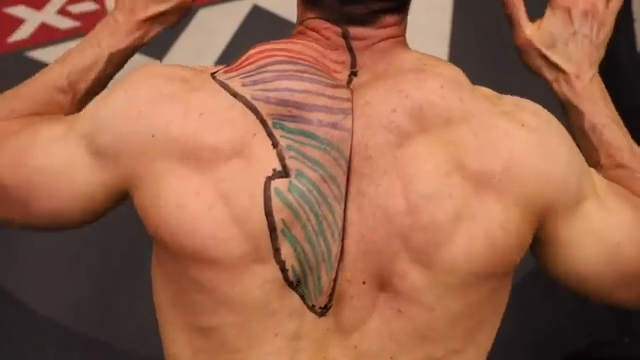
HOW TO DO THE STANDING PRONE PRESS:
- Similar to a Y-Press, you’ll stand up straight, hinge at the hips, and maintain a flat back.
- Extend your arms straight ahead, not out to the sides. Imagine yourself making an “I” shape with your upper body. Focus on the contraction in your lower traps.
- Squeeze at the top of the movement and slowly bring your arms back down.
WHAT MAKES IT EFFECTIVE: The key is to maintain a slightly retracted position to activate the middle traps. The primary focus is to raise your arms fully overhead, relying on the shoulder stability provided by the lower traps for smooth execution.
4) WHAT IS THE BEST DUMBBELL TRAPS WORKOUT?
Some of you might be saying, “But Jeff, I only have access to dumbbells. Are there any dumbbell trap exercises?”
Absolutely!
Here are my top trap exercises with dumbbells:
FARMER’S WALK


HOW TO DO THE FARMER’S WALK:
- Stand with your feet shoulder width apart holding a pair of dumbbells.
- Maintain a solid core and upright posture as you walk forward. Do not bend or twist. Focus on keeping your abdominal muscles contracted.
- Clasp the dumbbells securely to stimulate forearm muscle activity and enhance your grip position.
- You can stop after one to two minutes or at the point of fatigue where you’re not able to maintain your form. If you’re able to maintain correct form, go for heavy dumbbells here. Keep in mind that heavier dumbbells will burn out your grip faster.
WHAT MAKES IT EFFECTIVE: This classic exercise leverages the upper trap’s inherent load-bearing capacity, with the advantage of dumbbells aiding in isolating each trap side and enhancing grip strength.
KNEELING DUMBBELL SHRUGS

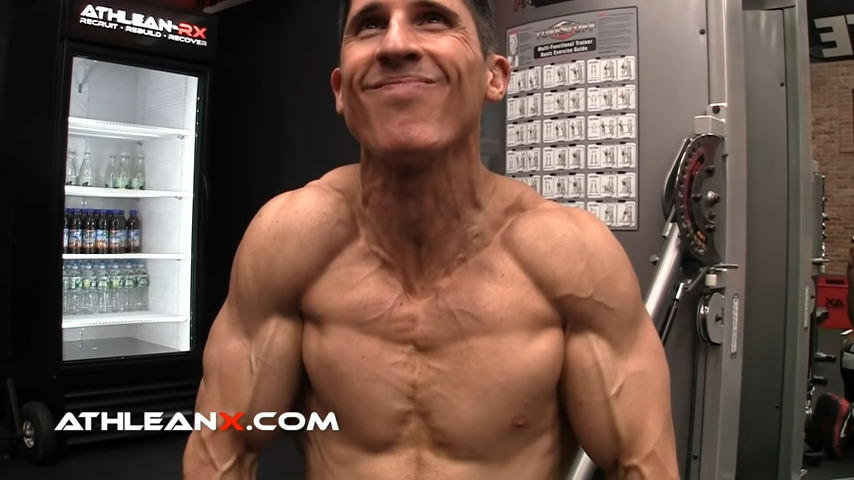
HOW TO DO KNEELING DUMBBELL SHRUGS:
- The starting position is on your knees, keeping your body upright and your core activated.
- Hold a dumbbell in each hand, palms inwards, arms extended, with a comfortable grip.
- Shrug your shoulders upwards, aiming for your ears, without bending elbows or using arms to lift.
- Briefly hold the peak position before lowering your shoulders back to start.
WHAT MAKES IT EFFECTIVE: Doing the Dumbbell Shrug while kneeling instead of standing removes any swinging motion, making it better for muscular isolation. This exercise works well for drop sets because the weights are close to the ground.
DUMBBELL PRONE PRESS


HOW TO DO THE DUMBBELL PRONE PRESS:
- Lie on the ground with light dumbbells in your hands, holding them with an overhand grip.
- Start with your arms in a “W” shape. Keep your head down and push the dumbbells forward without touching the ground.
- Focus on contracting your middle and lower trap muscles. Squeeze at the top and slowly return.
WHAT MAKES IT EFFECTIVE: Using light weights, when you lie down to perform this exercise, you eliminate the chance of using momentum to move the weight.
Y-PRESS

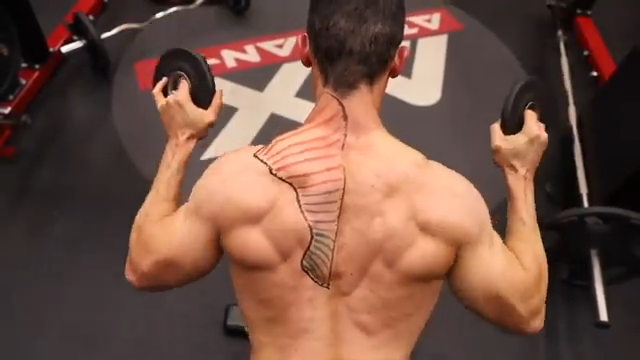
HOW TO DO THE Y-PRESS:
- Start by choosing light dumbbells. Stand with your feet shoulder-width apart, slightly bend your knees, and hinge forward at the hips while keeping your back straight.
- Tighten your core muscles. Begin with your elbows back, forming a “W” shape with your upper body and hold the weights at shoulder level.
- With a slight bend in your elbows, push the weights forward, widening your grip to create a “Y” shape.
- Extend your arms parallel to the ground. Pause and squeeze your lower traps, then slowly return to the starting position.
- Take your time and avoid rushing or using heavy weights. Focus on achieving a solid contraction with each repetition.
WHAT MAKES IT EFFECTIVE: The lower traps help stabilize and depress the shoulder blade during overhead movements. The Y-Press exercise is great for gradually introducing overhead rotation. Instead of going directly overhead, you raise your arms at a 45-degree angle. The wide range of motion at the top effectively targets the lower traps.
5) HOW TO DO TRAP WORKOUTS AT HOME
For those of you with access to weights, you’re all taken care of. But what about the guys who don’t have access to a gym or a variety of dumbbells?
Don’t worry, there are plenty of bodyweight trap exercises that work just as well as weights. And they are great for when you’re traveling or in desperate need of a trap workout with minimal equipment.
Here are my favorite body weight trap exercises:
BACKHAND TRAP SHRUGS


HOW TO DO BACKHAND TRAP SHRUGS:
- Lie on the ground with your legs extended in front of you. Place your hands at your sides with your palms facing forward.
- Lift your butt off the ground by contracting your upper and middle traps.
- Squeeze the trap muscles and then slowly lower your butt back to the ground, focusing more on the eccentric (lowering) than the concentric (lifting).
WHAT MAKES IT EFFECTIVE: This exercise is effective because it focuses on the eccentric (lowering) contraction. After you lift yourself up, you have to focus on slowly lowering yourself back down, engaging the traps the entire time.
POWER PUSH AWAY

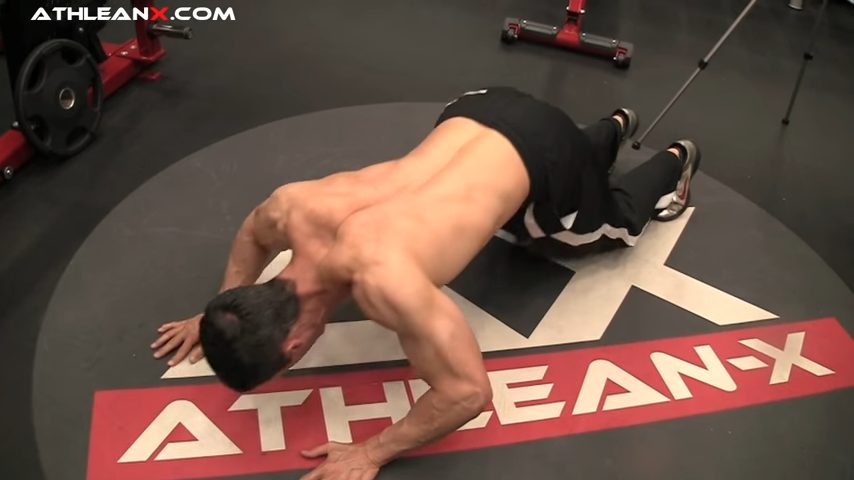
HOW TO DO THE POWER PUSH AWAY:
- Come down into a kneeling position. Put your hands on the ground in front of you.
- Bring your knees slightly off the ground, focusing the weight into your upper body, and using your feet for stability.
- Move your upper body forward and then push away, focusing all of the contraction in your trap muscles. Be sure to go slow with this one.
WHAT MAKES IT EFFECTIVE: This exercise taps into the elevation function of the traps in order to push the body away.
REVERSE PUSH-UPS


HOW TO DO REVERSE PUSH-UPS:
- Situate yourself beneath a Smith machine or a standard barbell in a power rack (same piece of equipment you use for Rack Pulls).
- Anchor your feet on the ground and hold on to the barbell.
- Maintain a strong core as you slide forward and lift your upper body. You’ll feel a strong pull in your traps.
- Move slowly, especially as you lower yourself.
WHAT MAKES IT EFFECTIVE: You’re going to experience an intense contraction and hold with this exercise. This is happening because of the elevation of the scapula as you go up, then the retraction is trying to hold this contraction against gravity.
ANGEL AND DEVIL

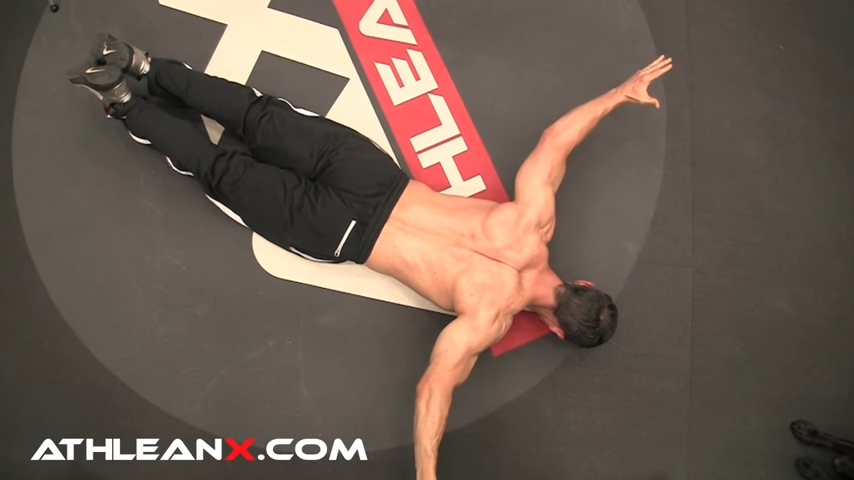
HOW TO DO THE ANGEL AND DEVIL:
- Lie on your stomach with your feet extended behind you and your hands extended in front of you. Make sure your fingers are touching at the top.
- With your fingers pointed straight, slowly begin to bring your arms to the sides. Focus on moving your arms via your traps only.
- Once you reach the bottom, reverse the movement. Again, move slowly, focusing on an intense contraction in your traps since this is where all of the movement should be happening.
WHAT MAKES IT EFFECTIVE: This one exercise takes the traps through each of the functions of the muscle via a fuller range of motion. Although you aren’t using weight, you’ll definitely feel this one.
RETRACTED PLANKS

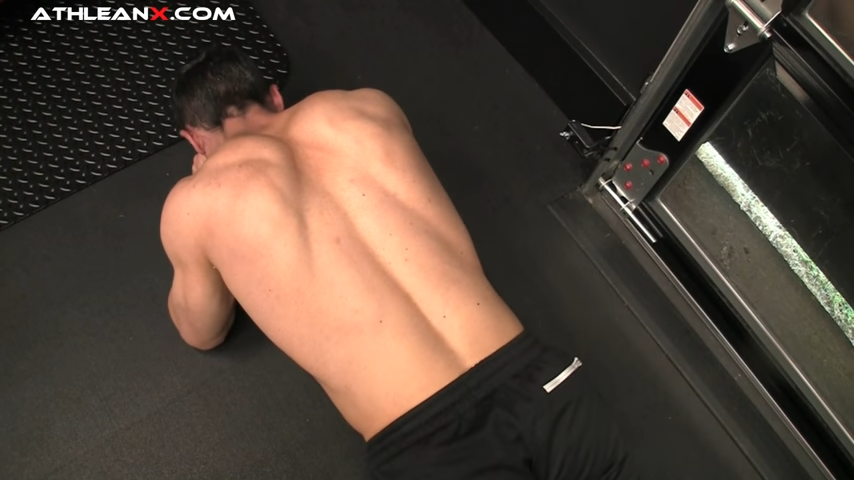
HOW TO DO RETRACTED PLANKS:
- Begin in a plank position on your forearms and toes.
- Lean forward, engaging the traps to control the movement.
- Move back to the starting position, then sink your upper body toward the floor. Maintain a flat back and solid core as you depress the scapula.
- Engage the mid and lower traps to lift yourself back up to where you started.
WHAT MAKES IT EFFECTIVE: Retracted Planks take you through two primary functions of the traps, challenging the muscles to work together to move the body forward and toward the floor. The trick is to let the traps do the work – Don’t rely on nearby muscles.
PULL-UP SHRUGS

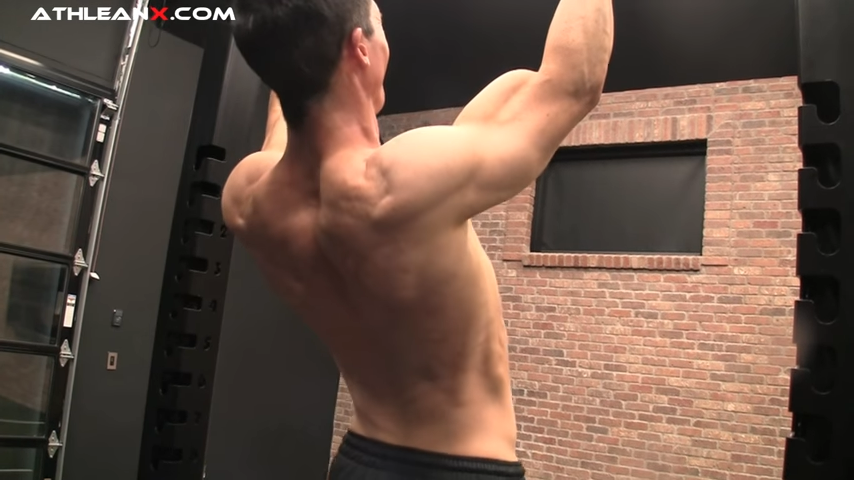
HOW TO DO PULL-UP SHRUGS:
- Hang from a pull-up bar taking a shoulder-width grip on the bar.
- Actively engage the lower traps to lift your upper body.
- Remember that you’re not trying to perform a traditional Pull-Up. What you’re trying to do is simply lift yourself up and all that contraction is coming from the lower traps. The movement is actually quite small compared to something like the Pull-Up.
- Once you’re at the top, squeeze the lower traps, and then lower yourself to the starting position. Aim for constant tension during the movement.
WHAT MAKES IT EFFECTIVE: You can see gravity just wants to have my body fall down, but I’ve got to actively engage those lower traps to pull my body back up.
6) WHAT ARE THE BEST TRAP WORKOUTS FOR MASS?
What if your goals focus on finding effective traps hypertrophy exercises? You want all the benefits of strength, posture, and aesthetics, but you also want huge traps.
If you want to focus on growing your traps, I’ve got the best trap workout for mass.
Here are two exercises that I’m sure you’ve seen before, but you’ve never performed them quite like this.
This is what I want you to do:
This trapezius workout involves a drop set of Barbell Shrugs with isometric holds to challenge your grip strength. Heavier weights are fine here but keep in mind that you need to perform these with perfect form.
When your grip fails, you’ll do 10 Overhead Plate Raises before returning to the Barbell Shrug drop set.
- Set a timer for six minutes.
- Start with 10 reps of Barbell Shrugs and hold for 10 seconds on the last one.
- Decrease the reps by one and hold for the corresponding number of seconds until you reach one rep and a one-second hold. (e.g., Hold for nine seconds after performing nine reps, etc.)
- When your grip gives out, do 10 reps of Overhead Plate Raises.
- Resume the Barbell Shrug drop set from where you left off.
- Repeat the process of doing Overhead Plate Raises whenever your grip fails until completing one rep and a one-second hold.
- If you finish the Barbell Shrug drop set before the time is up, hold the shrug position until the timer runs out.
And here’s how to perform the two exercises:
BARBELL SHRUG


HOW TO DO THE BARBELL SHRUG:
- Stand straight while holding a barbell with your hands slightly wider than shoulder-width apart, using an overhand grip. The barbell will sit well above knee height – This will be on the upper thighs for most people.
- Keep your arms straight throughout the exercise. Lift your shoulders up towards your ears, hold for a moment, and then lower them back down.
- It’s important to maintain proper form by using a weight that allows you to do the exercise correctly. Going too heavy too soon can put excessive stress in the wrong places.
WHAT MAKES IT EFFECTIVE: The Barbell Shrug allows the upper traps to do what they do best: move up and down. Given its range of motion, this is a great exercise to use heavy weight with – assuming you can maintain proper form throughout.
PLATE RAISE

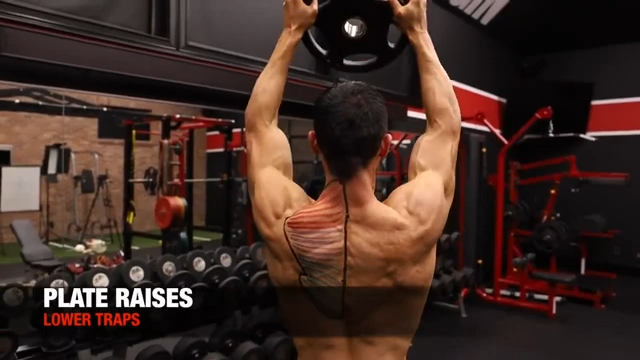
HOW TO DO THE PLATE RAISE:
- Begin with your feet shoulder-width apart. Hold a weight plate at hip level with a neutral grip.
- Raise your arms overhead, activating the lower traps to stabilize them. Focus on contracting the lower trap muscles strongly.
- Lower the weight slowly to work on the muscle’s lengthening phase, then raise it back up.
WHAT MAKES IT EFFECTIVE: This exercise targets the lower traps by focusing on stabilization. Take your time and move slowly while lowering the weight to emphasize the muscle lengthening.
Training your trapezius muscles, or traps, is vital for a balanced physique, improved posture, and enhanced functional strength.
The path to well-developed traps involves targeted exercises like Barbell Shrugs and Plate Overhead Raises and applying progressive overload principles.
Most importantly, you better be using proper form, avoiding poor posture, and focusing on quality reps over quantity.
Remember, consistency in training, coupled with adequate nutrition and recovery, will help you achieve the powerful, defined traps you’re aiming for.
If you’re looking for a complete training program to build lean muscle and strength in every muscle group in the body and improve your physique, see which of our ATHLEAN-X programs best suits your fitness goals and equipment possibilities.
TRAP WORKOUTS FAQ
The barbell shrug exercise is known for developing big traps as it primarily targets the upper trapezius muscles.
It also allows you to use more weight than you normally would with other trap exercises.
I’d recommend pairing the Barbell Shrug with an Overhead Plate Raise. Perform a drop set of the two exercises starting from 10 reps. At the end of each set, hold the shrug for the same number of seconds as the reps.
If you want to build bigger traps faster, you need to use a combination of the right exercises and the right techniques.
Try a superset of Barbell Shrugs with Overhead Plate Raises. Perform drop sets, starting at 10 reps and at the end of each set, hold the shrug for the same number of seconds.
You also want to use some progressive overload techniques, gradually increasing the weight, reps, sets, or frequency of your trap-focused exercises. You can also decrease rest time between sets.
Yes! Training your trapezius muscles promotes a balanced, strong upper body, helping to improve posture and reduce the risk of injury, especially shoulder pain.
Stronger traps contribute to better performance in many functional movements and athletic activities, from lifting heavy objects to swimming or throwing.
Additionally, well-developed traps are a great aesthetic goal to have. Balanced traps can enhance the aesthetics of your physique, contributing to a broader, more powerful looking upper body.
Your traps might not be growing due to a few possible causes – all of which are common if you have little experience in weightlifting.
You might not be stressing them enough with the right lifts to see increased muscle mass. That means you might not be using the best exercises for trap growth. Or you're not applying the principle of progressive overload by gradually increasing weight, reps, sets or frequency.
It could also be due to poor form or technique and a lack of controlled steps in your exercises, causing other muscles to take over the work.
It might also have something to do with inadequate nutrition, especially protein intake. A lack of proper rest and recovery can also hinder muscle growth in your traps.
The best trap workouts focus on all three sections of the trap muscles. You want to focus on exercises that tap into all of the functions of the traps.
Here’s a great trap workout to follow:
This depends on which section of the traps you want to target.
If you want to build your upper traps, perform the Barbell Shrug.
If you’re targeting the mid traps, use the Back Widow.
If you’re going after your lower traps, I’d recommend the Cable Overhead Trap Raise.
If you don’t have access to a full gym or weights, you can use the following bodyweight trap exercises at home:
While push-ups primarily target the chest, shoulders, and triceps, they do engage the trapezius muscles as stabilizers.
However, the engagement isn't enough to significantly stimulate growth or strength in your traps.
For trap-specific growth, exercises such as the Barbell Shrug, Farmer’s Carry, or Face Pull Overhead Press are more effective.
Making your traps bigger involves a few key elements. First, you want to consistently perform exercises for muscle growth that directly target the trapezius muscles like Barbell Shrugs and Back Widows.
Next, you want to use the principle of progressive overload (increasing the weight, sets, reps, or frequency over time).
Finally, good nutrition with adequate protein intake, combined with sufficient rest and recovery, are also essential for muscle growth.
To target the upper traps, you want to use exercises that target the muscle fibers that that start at the base of the skull and move downwards and outwards.
That means you’ll want to use shrugging and pulling movements. Here are some of the best exercises to target the upper traps:
REFERENCES

Jeff Cavaliere M.S.P.T, CSCS
Jeff Cavaliere is a Physical Therapist, Strength Coach and creator of the ATHLEAN-X Training Programs and ATHLEAN-Rx Supplements. He has a Masters in Physical Therapy (MSPT) and has worked as Head Physical Therapist for the New York Mets, as well as training many elite professional athletes in Major League Baseball, NFL, MMA and professional wrestling. His programs produce “next level” achievements in muscle size, strength and performance for professional athletes and anyone looking to build a muscular athletic physique.
















